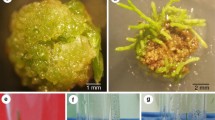Abstract
Genetic transformation of plants mediated by Ri plasmid ofAgrobacterium rhizogenes occupies a special place in plant cell engineering, since this technique based on a natural phenomenon allows cultivation of isolated growing plant roots on hormone-free media. Application of wild-type unmodified agrobacterial strains allows us to obtain root cultures capable of long-term growth in vitro due to an increased sensitivity of the cells to auxins while other biochemical properties remain unaltered. A collection of pRi T-DNA transformed roots of certain dicotyledons was made; some strains in it are used to study synthesis of secondary metabolites in root cells. Thein vitro cultivated roots could synthesize root-specific metabolites, which makes possible their application for large-scale biotechnological production of ecologically pure crude drugs. Cocultivation of pRi T-DNA transformed roots with arbuscular mycorrhizal fungi makes possible vital study of all stages of obligate symbiont development and interaction with plant roots. Dual axenic culture of AM fungi and pRi T-DNA transformed plants can be used to make a collection of the most valuable endomycorrhizal fungal species and to produce considerable quantities of homogeneous fungal inoculums.
Similar content being viewed by others
REFERENCES
Bécard, G. and Fortin, J.A., Early Events of Vesicular-Arbuscular Mycorrhiza Formation on Ri T-DNA-Transformed Roots, New Phytol., 1988, vol. 108, pp. 211-218.
Bécard, G. and Piche, Y., Physiological Factors Determining Vesicular-Arbuscular Mycorrhizal Formation in Host and Nonhost Ri T-DNA-Transformed Roots, Can. J. Bot., 1990, vol. 55, pp. 1260-1264.
Diop, T.A., Plenchette, C., and Strullu, D.G., Dual Axenic Culture of Sheared-Root Inocula of Vesicular-Arbuscular Mycorrhizal Fungi Associated with Tomato Roots, Mycorrhiza, 1994, vol. 5, pp. 17-22.
Doran, P.M., Prospects for Production of Plant Chemicals from Genetically Transformed Roots, Austral. J. Biotechnol., 1989, vol. 3, no. 4, pp. 270-277.
Gerdemann, J.W. and Nicolson, T.H., Spores of Mycorrhizal Endogone Species Extracted from Soil by Wet Sieving and Decanting, Trans. Br. Mycol. Soc., 1963, vol. 46, pp. 233-244.
Gol'dberg, E.D., Dygai, A.M., Litvinenko, V.I., Popova, T.P., and Suslov, N.I., Shlemnik baikal'skii. Fitokhimiya i farmakologicheskie svoistva (Baikal Skullcap. Phytochemistry and Pharmaceutical Properties), Tomsk: Izd. Tomsk Univ., 1994.
Karandashov, V.E., Kuzovkina, I.N., George, E., and Marshner, Kh., Monoxenic Culture of Arbuscular Mycorrhizal Fungi and Plant Hairy Roots, Fiziol. Rast., 1999, vol. 46, no. 1, pp. 102-108.
Karandashov, V., Kuzovkina, I., Hawkins, H.-J., and George, E., Growth and Sporulation of the Arbuscular Mycorrhizal Fungus Glomus caledonium in Dual Culture with Transformed Carrot Roots, Mycorrhiza, 2000, vol. 10, pp. 23-28.
Kuzovkina, I.N., Cultivation of Genetically Transformed Plant Roots: Possibilities and Prospects for Plant Physiology, Fiziol. Rast., 1992, vol. 39, no. 6, pp. 1208-1214.
Kuzovkina, I.N., Mantrova, O.V., Al'terman, I.E., and Yakimov, S.A., Culture of Genetically Transformed Hairy Roots Derived from Anthraquinone-producing European Madder Plants, Fiziol. Rast., 1996, vol. 43, no. 2, pp. 291-298.
Kuzovkina, I.N., Guseva, A.V., Al'terman, I.E., and Karnachuk, R.A., Flavonoid Production in Transformed Scutellaria baicalensis Roots and Ways of Its Regulation, Fiziol. Rast., 2001, vol. 48, no. 4, pp. 523-528.
Mantrova, O.V., Dunaeva, M.V., Kuzovkina, I.N., Shnaider, B., and Myuller-Uri, F., Effect of Methyl Jasmonate on Anthraquinone Biosynthesis in Transformed Madder Roots, Fiziol. Rast., 1999, vol. 46, no. 2, pp. 292-295.
Mertz, S.M., Heithaus, J.J., and Bush, R.J., Mass Production of Axenic Spores of the Endomycorrhizal Fungius Gigaspora Margarita, Trans. Br. Mycol. Soc., 1979, vol. 72, pp. 167-169.
Partier, B., Jasmonates, New Regulators of Plant Growth and Development: Many Facts and Few Hypotheses on Their Action, Bot. Acta, 1991, vol. 104, no. 2, pp. 446-454.
Tang, W. and Eisenbrand, G., Chinese Drugs of Plant Origin. Chemistry, Pharmacology, and Use Traditional and Modern Medicine, Berlin: Springer, 1992, pp. 919-935.
Tepfer, D., Biology of Genetic Transformation of Higher Plants with Agrobacterium rhizogenes, Molekulyarnaya genetika vzaimodeistviya bakterii s rasteniyami (Molecular Genetics of Interaction between Bacteria and Plants), Moscow: Agropromizdat, 1988, pp. 272-282.
Turova, A.D., Lekarstvennye rasteniya SSSR i ikh primenenie (Herbs of the USSR and Their Application), Moscow: Meditsina, 1967.
Author information
Authors and Affiliations
Rights and permissions
About this article
Cite this article
Kuzovkina, I.N., Al'terman, I.E. & Karandashov, V.E. Genetically Transformed Plant Roots as a Model for Studying Specific Metabolism and Symbiotic Contacts of the Root System. Biology Bulletin 31, 255–261 (2004). https://doi.org/10.1023/B:BIBU.0000030146.87748.f0
Issue Date:
DOI: https://doi.org/10.1023/B:BIBU.0000030146.87748.f0




